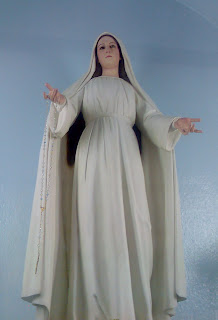The Four Marian Dogmas Part 2

3) Immaculate Conception
The solemn definition of Mary's Immaculate Conception is like Divine Motherhood and Perpetual Virginity part of the christological doctrine, but it was proclaimed as an independent dogma by Pope Pious IX in his Apostolic Constitution "Ineffabilis Deus" (December 8, 1854). Though highlighting a privilege of Mary it in fact stresses the dignity and holiness required to become "Mother of God." The privilege of the Immaculate Conception is the source and basis for Mary's all-holiness as Mother of God.
More specifically, the dogma of the Immaculate Conception states "that the most Blessed Virgin Mary, from the first moment of her conception, by a singular grace and privilege from Almighty God and in view of the merits of Jesus Christ, was kept free of every stain of original sin."
This dogma has both a "negative" and a "positive" meaning which complement each other. The "negative" meaning stresses Mary's freedom from original sin thanks to the anticipated or retroactive (here called preventive) grace of Christ's redemptive act. By the same token, the dogma suggests Mary's all-holiness. This "positive" meaning is the consequence of the absence of original sin. Mary's life is permanently and intimately related to God, and thus she is the all-holy.
Although difficult to explain, original sin provokes disorderliness in thought and behavior, especially with regard to the primacy of God's presence in our life. Consequently, in declaring Mary immaculately conceived, the Church sees in Mary one who never denied God the least sign of love. Thus, the dogma declares that from her beginning Mary was exceptionally holy and in constant union with the sanctifying grace of the Holy Spirit.
4) The Assumption
This marian dogma was proclaimed by Pope Pius XII on November 1, 1950 on his Encyclical Munificentissimus Deus.
A distinction needs to be made between Ascension and Assumption. Jesus Christ, Son of God and Risen Lord, ascended into heaven, a sign of divine power. Mary, on the contrary, was elevated or assumed into heaven by the power and grace of God.
The dogmas states that "Mary, Immaculate Mother of God ever Virgin, after finishing the course of her life on earth, was taken up in body and soul to heavenly glory." This definition as well as that of the Immaculate Conception makes not only reference to the universal, certain and firm consent of the Magisterium but makes allusion to the concordant belief of the faithful. The Assumption had been a part of the Church's spiritual and doctrinal patrimony for centuries. It had been part of theological reflection but also of the liturgy and was part of the sense of the faithful.
This dogma has no direct basis in scripture. It was nonetheless declared "divinely revealed," meaning that it is contained implicitly in divine Revelation. It may be understood as the logical conclusion of Mary's vocation on earth, and the way she lived her life in union with God and her mission. The assumption may be seen as a consequence of Divine Motherhood. Being through, with, and for her Son on earth, it would seem fitting for Mary to be through, with, and for her Son in heaven, too. She was on earth the generous associate of her Son. The Assumption tells us that this association continues in heaven. Mary is indissolubly linked to her Son on earth and in heaven.
In heaven, Mary's active involvement in salvation history continues: "Taken up to heaven, she did not lay aside her salvific duty ... By her maternal love she cares for the brothers and sisters of her Son who still journey on earth" (LG). Mary is the "eschatological icon of the Church" (CCC 972), meaning the Church contemplates in Mary her own end of times.
The definition of the dogma does not say how the transition from Mary's earthly state to her heavenly state happened. Did Mary die? Was she assumed to heaven without prior separation of soul and body? The question remains open for discussion. However, the opinion that Mary passed through death as her Son did, has the stronger support in tradition.
The definition of the dogma does not say how the transition from Mary's earthly state to her heavenly state happened. Did Mary die? Was she assumed to heaven without prior separation of soul and body? The question remains open for discussion. However, the opinion that Mary passed through death as her Son did, has the stronger support in tradition.
Glorified in body and soul, Mary is already in the state that will be ours after the resurrection of the dead.
Labels: Articles, Marian Dogmas


